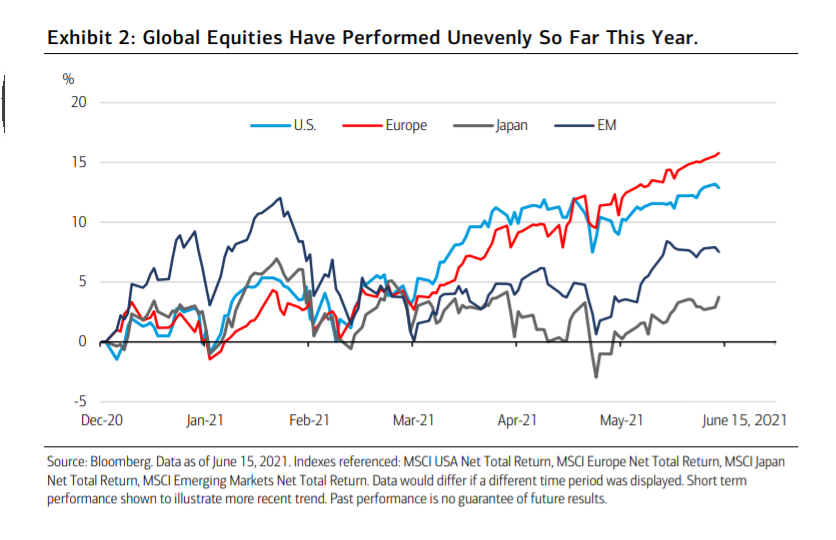Merrill har analyseret aktiemarkedernes udvikling i år og konstaterer, at de europæiske aktier har klaret sig bedre end alle andre i de seneste måneder, også de amerikanske. Value har klaret sig bedre end vækstaktier. Virksomhedernes indtjeningsvækst har været forrygende i år, men den ventes at falde markant næste år. Der har generelt været meget store udsving i dette halvår på aktiemarkederne i Japan og Emerging Markets.
A Mid-year Glimpse at Global Equities
Heading into mid-year, global equity performance has proven somewhat uneven with the
U.S. and Europe surging ahead while Japan and the EM lag behind (Exhibit 2). Here we
recount what we have seen so far and what investors should consider into the second half
of the year as potential drivers for further performance differentials shape out.

U.S.
The U.S. currently continues to be a leader in the global recovery on the back of strong
economic data, an improving coronavirus situation and a stimulative policy mix. Several
factors suggest that further upside for growth and corporate profits lie ahead, with a
pickup in spending, an expected increase in labor market engagement as coronavirus risks
subside and as elevated corporate cash levels drive a new capital expenditures (capex)
cycle, building out a positive backdrop for U.S. equity performance. So far, U.S. equities
have done well under these conditions, with the S&P 500 up 13.8% on total return basis
year-to-date (YTD).
Strong earnings have helped to solidify investor confidence in the economic recovery. The
first quarter saw S&P 500 earnings beat consensus estimates by a record 21%.1 Given
that we still remain at the early stages of the consumer pent-up demand cycle,
expectations for revenues should continue to move higher. BofA Global Research expects
earnings growth of 29.4% for 2021 and 10.8% for 2022, although potential tax hikes
remain a primary downside risk. The strengthening earnings recovery has been a major
driver of the recent rally, which is typical in the second year of a recovery. Whereas
multiple expansion fueled much of the equity returns last year, valuations have
compressed with the forward price-to-earnings (P/E) multiple down 6% since the start of
the year, moving from 22.6x to 21.3x.
Participation remains broad, with roughly 92% of companies in the S&P 500 trading above
their 200-day moving average. As vaccination progress boosts broader reopening
prospects and profit momentum accelerates across the board, the rotation toward more
economically-sensitive areas of the market should continue, in our opinion. So far, Value
has trounced Growth, with the Russell 1000 Value up 18.2% while the growth index
lagged, now up only 8.9%. Value outperformance is closely tied to the economic cycle
given its higher exposure to cyclical sectors like Energy and Financials, both sector leaders
so far this year. These areas of the market have seen higher earnings revisions relative to
more secular growth sectors, and should continue to benefit from a rising inflation and
interest rate environment. From a valuation perspective, improving earnings have
supported more attractive valuations for Value, with the Value forward P/E at 17.7x
compared to 28.4x for growth. Small-caps have similarly outperformed large-caps, on the
back of an improving economic outlook and stronger earnings recovery, with the next 12
month’s earnings estimates for the Russell 2000 above the highs from 2018.
Recently, U.S. equities have traded in a narrower range as investors try to digest
implications of rising inflation on monetary policy after the U.S. CPI for May reported a 5%
YoY increase, the first report of its kind since 2008. Fed officials continue to present any
near term inflation as “transitory,” essentially affirming the central bank’s accommodative
policy stance. For now, the trajectory for U.S. equities remains positive.
International Developed
Looking beyond the shores of the U.S., international equity performance has been
relatively strong with the MSCI World Ex-U.S. Index up 13.6% YTD. Earnings recovery has
picked up with estimated growth of 41% this year, and valuations remain attractive.3
However, the pace of economic reopening has varied across countries. The U.K, for
instance, continues to struggle with new coronavirus variants and resulting economic
shutdowns, while reopening has gathered momentum more quickly in other areas.
Performance dispersion will likely remain until the health front normalizes, but as
inoculations continue there may be a sustained pickup in growth momentum across
International Developed markets. We are already seeing signs of this in some places, with
certain International Developed markets far outpacing the U.S. this year.
European equities have surged ahead of the U.S. and other global peers in recent months
as an acceleration in vaccinations pushed the region closer toward reopening. The MSCI
Europe Index is now up 16.3% on a total return basis YTD, widening out the performance
differential with the rest of the world. May marked the fourth consecutive month of
positive performance for the region, with the index up 4.7% and June on track for a fifth as
new all-time highs continue to be reached. The region’s more value-dominated stock
market has benefited from the improving economic recovery and rising interest rates, with
Banks up 27% and Energy and Consumer Discretionary up 20.3% each YTD.
Further economic surprises support a strong corporate earnings outlook. Following record Q1
earnings beats, Europe’s earnings revision ratio jumped to 2.20 in May, the highest level
ever. Consensus expectations are calling for earnings to grow 44% for 2021 and 10% for
2022.
European stocks have benefited from the latest advance in the recovery and from strong
inflows, following nine straight weeks of positive fund flows, according to BofA Global
Research, but not all risks have been abated. A combination of coronavirus setbacks, a
slower recovery in consumption, political cycle volatility, and input cost pressures and
supply chain shortages all pose a risk, but for now the European Central Bank remains
committed to its accommodative policy. That said, European equities should continue to
stay afloat given attractive valuations relative to the U.S. with the MSCI Europe forward
P/E at 16.6x, rising bond yields rewarding banks stocks and economic growth momentum
in place.





